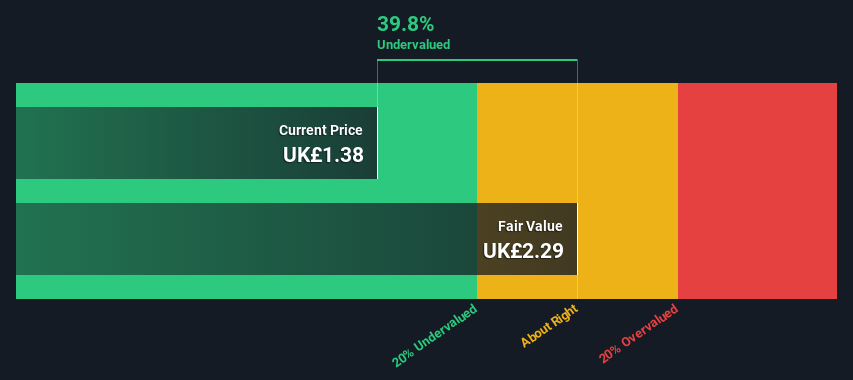- United Kingdom
- /
- Specialty Stores
- /
- LSE:JD.
JD Sports Fashion Plc's (LON:JD.) Intrinsic Value Is Potentially 66% Above Its Share Price

Key Insights
- The projected fair value for JD Sports Fashion is UK£2.29 based on 2 Stage Free Cash Flow to Equity
- JD Sports Fashion is estimated to be 40% undervalued based on current share price of UK£1.38
- Analyst price target for JD. is UK£1.67 which is 27% below our fair value estimate
Today we'll do a simple run through of a valuation method used to estimate the attractiveness of JD Sports Fashion Plc (LON:JD.) as an investment opportunity by projecting its future cash flows and then discounting them to today's value. Our analysis will employ the Discounted Cash Flow (DCF) model. Before you think you won't be able to understand it, just read on! It's actually much less complex than you'd imagine.
Remember though, that there are many ways to estimate a company's value, and a DCF is just one method. Anyone interested in learning a bit more about intrinsic value should have a read of the Simply Wall St analysis model.
Check out our latest analysis for JD Sports Fashion
Is JD Sports Fashion Fairly Valued?
We are going to use a two-stage DCF model, which, as the name states, takes into account two stages of growth. The first stage is generally a higher growth period which levels off heading towards the terminal value, captured in the second 'steady growth' period. To start off with, we need to estimate the next ten years of cash flows. Where possible we use analyst estimates, but when these aren't available we extrapolate the previous free cash flow (FCF) from the last estimate or reported value. We assume companies with shrinking free cash flow will slow their rate of shrinkage, and that companies with growing free cash flow will see their growth rate slow, over this period. We do this to reflect that growth tends to slow more in the early years than it does in later years.
Generally we assume that a dollar today is more valuable than a dollar in the future, so we need to discount the sum of these future cash flows to arrive at a present value estimate:
10-year free cash flow (FCF) forecast
| 2025 | 2026 | 2027 | 2028 | 2029 | 2030 | 2031 | 2032 | 2033 | 2034 | |
| Levered FCF (£, Millions) | UK£291.0m | UK£412.8m | UK£599.1m | UK£651.0m | UK£725.0m | UK£779.3m | UK£824.7m | UK£863.1m | UK£896.2m | UK£925.5m |
| Growth Rate Estimate Source | Analyst x4 | Analyst x4 | Analyst x3 | Analyst x1 | Analyst x1 | Est @ 7.49% | Est @ 5.82% | Est @ 4.65% | Est @ 3.84% | Est @ 3.27% |
| Present Value (£, Millions) Discounted @ 7.9% | UK£270 | UK£355 | UK£477 | UK£481 | UK£497 | UK£495 | UK£485 | UK£471 | UK£453 | UK£434 |
("Est" = FCF growth rate estimated by Simply Wall St)
Present Value of 10-year Cash Flow (PVCF) = UK£4.4b
The second stage is also known as Terminal Value, this is the business's cash flow after the first stage. The Gordon Growth formula is used to calculate Terminal Value at a future annual growth rate equal to the 5-year average of the 10-year government bond yield of 1.9%. We discount the terminal cash flows to today's value at a cost of equity of 7.9%.
Terminal Value (TV)= FCF2034 × (1 + g) ÷ (r – g) = UK£925m× (1 + 1.9%) ÷ (7.9%– 1.9%) = UK£16b
Present Value of Terminal Value (PVTV)= TV / (1 + r)10= UK£16b÷ ( 1 + 7.9%)10= UK£7.5b
The total value, or equity value, is then the sum of the present value of the future cash flows, which in this case is UK£12b. The last step is to then divide the equity value by the number of shares outstanding. Compared to the current share price of UK£1.4, the company appears quite undervalued at a 40% discount to where the stock price trades currently. Valuations are imprecise instruments though, rather like a telescope - move a few degrees and end up in a different galaxy. Do keep this in mind.

The Assumptions
Now the most important inputs to a discounted cash flow are the discount rate, and of course, the actual cash flows. Part of investing is coming up with your own evaluation of a company's future performance, so try the calculation yourself and check your own assumptions. The DCF also does not consider the possible cyclicality of an industry, or a company's future capital requirements, so it does not give a full picture of a company's potential performance. Given that we are looking at JD Sports Fashion as potential shareholders, the cost of equity is used as the discount rate, rather than the cost of capital (or weighted average cost of capital, WACC) which accounts for debt. In this calculation we've used 7.9%, which is based on a levered beta of 1.224. Beta is a measure of a stock's volatility, compared to the market as a whole. We get our beta from the industry average beta of globally comparable companies, with an imposed limit between 0.8 and 2.0, which is a reasonable range for a stable business.
SWOT Analysis for JD Sports Fashion
- Earnings growth over the past year exceeded the industry.
- Debt is not viewed as a risk.
- Dividend is low compared to the top 25% of dividend payers in the Specialty Retail market.
- Annual revenue is forecast to grow faster than the British market.
- Good value based on P/E ratio and estimated fair value.
- Annual earnings are forecast to grow slower than the British market.
Moving On:
Whilst important, the DCF calculation ideally won't be the sole piece of analysis you scrutinize for a company. DCF models are not the be-all and end-all of investment valuation. Instead the best use for a DCF model is to test certain assumptions and theories to see if they would lead to the company being undervalued or overvalued. For example, changes in the company's cost of equity or the risk free rate can significantly impact the valuation. Can we work out why the company is trading at a discount to intrinsic value? For JD Sports Fashion, we've put together three important aspects you should further research:
- Risks: Every company has them, and we've spotted 1 warning sign for JD Sports Fashion you should know about.
- Management:Have insiders been ramping up their shares to take advantage of the market's sentiment for JD.'s future outlook? Check out our management and board analysis with insights on CEO compensation and governance factors.
- Other High Quality Alternatives: Do you like a good all-rounder? Explore our interactive list of high quality stocks to get an idea of what else is out there you may be missing!
PS. The Simply Wall St app conducts a discounted cash flow valuation for every stock on the LSE every day. If you want to find the calculation for other stocks just search here.
New: Manage All Your Stock Portfolios in One Place
We've created the ultimate portfolio companion for stock investors, and it's free.
• Connect an unlimited number of Portfolios and see your total in one currency
• Be alerted to new Warning Signs or Risks via email or mobile
• Track the Fair Value of your stocks
Have feedback on this article? Concerned about the content? Get in touch with us directly. Alternatively, email editorial-team (at) simplywallst.com.
This article by Simply Wall St is general in nature. We provide commentary based on historical data and analyst forecasts only using an unbiased methodology and our articles are not intended to be financial advice. It does not constitute a recommendation to buy or sell any stock, and does not take account of your objectives, or your financial situation. We aim to bring you long-term focused analysis driven by fundamental data. Note that our analysis may not factor in the latest price-sensitive company announcements or qualitative material. Simply Wall St has no position in any stocks mentioned.
About LSE:JD.
JD Sports Fashion
Engages in the retail of branded sports fashion and outdoor clothing, footwear, accessories, and equipment for kids, women, and men in the United Kingdom, Republic of Ireland, Europe, North America, and internationally.
Undervalued with reasonable growth potential.

